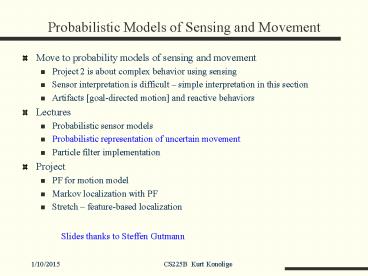Probabilistic Models of Sensing and Movement PowerPoint PPT Presentation
Title: Probabilistic Models of Sensing and Movement
1
Probabilistic Models of Sensing and Movement
- Move to probability models of sensing and
movement - Project 2 is about complex behavior using sensing
- Sensor interpretation is difficult simple
interpretation in this section - Artifacts goal-directed motion and reactive
behaviors - Lectures
- Probabilistic sensor models
- Probabilistic representation of uncertain
movement - Particle filter implementation
- Project
- PF for motion model
- Markov localization with PF
- Stretch feature-based localization
Slides thanks to Steffen Gutmann
2
Robot Motion
- Robot motion is inherently uncertain.
- How can we model this uncertainty?
3
Dynamic Bayesian Network for Controls, States,
and Sensations
4
Probabilistic Motion Models
- To implement the Bayes Filter, we need the
transition model p(x x, u). - The term p(x x, u) specifies a posterior
probability, that action u carries the robot from
x to x. - In this section we will specify, how p(x x,
u) can be modeled based on the motion equations. - We concentrate on wheel-based robots for legged
ones, similar equations hold.
5
Coordinate Systems
- In general the configuration of a robot can be
described by six parameters. - Three-dimensional Cartesian coordinates plus
three Euler angles pitch, roll, and tilt. - Throughout this section, we consider robots
operating on a planar surface.
- The state space of such systems is
three-dimensional (x,y,?).
6
Typical Motion Models
- In practice, one often finds two types of motion
models - Odometry-based
- Velocity-based (dead reckoning)
- Odometry-based models are used when systems are
equipped with encoders that can measure the
actual path traveled. - Velocity-based models have to be applied when no
encoders are given. - They calculate the new pose based on the
velocities and the time elapsed.
7
Example Wheel Encoders
- These modules require 5V and GND to power them,
and provide a 0 to 5V output. They provide 5V
output when they "see" white, and a 0V output
when they "see" black.
These disks are manufactured out of high quality
laminated color plastic to offer a very crisp
black to white transition. This enables a wheel
encoder sensor to easily see the transitions.
Source http//www.active-robots.com/
8
Dead Reckoning
- Derived from deduced reckoning.
- Mathematical procedure for determining the
present location of a vehicle. - Achieved by calculating the current pose of the
vehicle based on its velocities and the time
elapsed, over small time intervals
9
Reasons for Motion Errors
and many more
10
Odometry Model
- Robot moves from to .
- Odometry information .
11
The atan2 Function
- Extends the inverse tangent and correctly copes
with the signs of x and y.
12
Noise Model for Odometry
- The measured motion is given by the true motion
corrupted with noise.
13
Variances and Deviations
- For independent errors, variances add.
- If errors are specified using std, the length
over which the error occurs must be given - 6 cm in 1 m gt 36 cm2 in 1 m
- 3 deg in 360 deg gt 9 deg2 in 360 deg
- Consider to
specify a variance
14
Typical Distributions for Probabilistic Motion
Models
Normal distribution
Triangular distribution
15
Calculating the Posterior given x, x, and u
- Algorithm motion_model_odometry(x,x,u)
- return p1 p2 p3
16
Application
- Typical banana-shaped distributions obtained for
2d-projection of 3d posterior.
p(xu,x)
x
x
u
u

